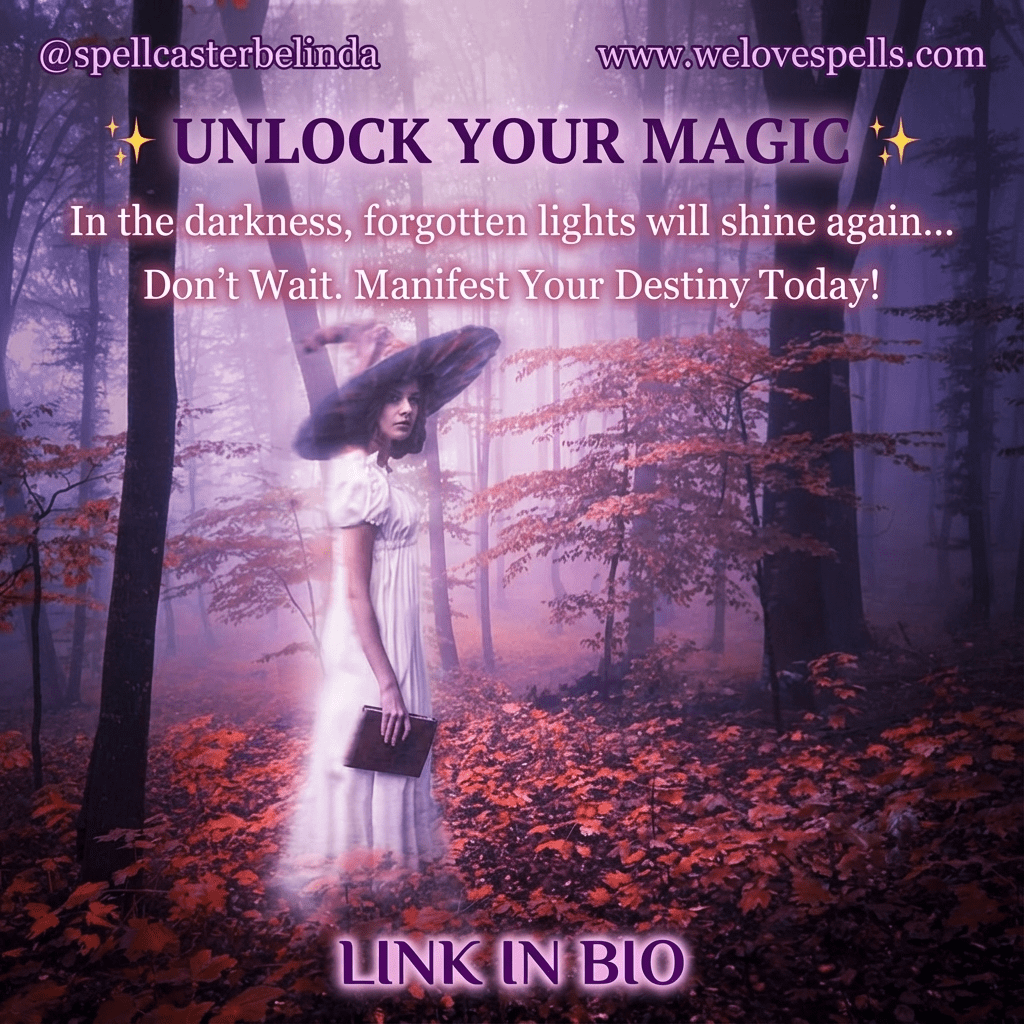Unraveling the Mysteries of Astrology and Witchcraft: Harnessing its Ancient Power
How Do Love Spells Work?
- Focused intention + ethical ritual directs energy toward love, reconciliation, and relationship healing.
- Astrology timing (moon phases, Venus transits) amplifies spellcasting results and synchronicity.
- Magical tools like candles, herbs, crystals, and sigils help anchor intent and protect your space.
- “Harm none” ethics and respect for free will keep spellwork compassionate and in alignment.
- Realistic expectations: results can unfold gradually; journaling and small daily practices deepen outcomes.
Unlock the Ancient Power of Witchcraft & Astrology
Step into the mystical world where magic, love, and the cosmos align. Learn how witchcraft and astrology shape destiny, inspire transformation, and empower everyday lives.
Ready to invite lasting love and clarity? Shop real love spells that work today or buy love spells online from verified spell casters.

Get your spell cast by the best spell caster in the world for clarity, love, and peace.
What Is Witchcraft?
Witchcraft is a living spiritual tradition that harnesses natural, spiritual, and cosmic energies to create meaningful change. It blends spells, ritual, and divination with a deep respect for nature and the unseen.
Far beyond folklore, witchcraft is a path of self-discovery, empowerment, and transformation. When combined with astrology, it becomes a powerful way to align your life with the rhythms of the universe.
Want to rekindle romance or attract your soulmate? Explore our curated love spells collection to ignite your journey with intention and care.
Witchcraft Through Time: Origins, Trials, and Renewal
Ancient Roots
Echoes of witchcraft appear across Mesopotamia, Egypt, and indigenous cultures worldwide. Early practitioners served as healers, seers, and wisdom keepers—guardians of sacred rites and the mysteries of nature.
Misunderstood and Feared
History records devastating periods—like European witch hunts and the Salem Witch Trials—where fear and superstition led to persecution, often of women. These chapters remind us how easily spiritual practices can be misrepresented.
Modern Revival
Today, witchcraft flourishes through Wicca and neo-pagan movements that honor nature, personal empowerment, and the divine feminine. This renaissance blends tradition with intent for love, healing, and growth.

Core Beliefs and Magical Practices
- Elements of Nature: Earth, Air, Fire, and Water are invoked to balance energy and strengthen outcomes.
- Spells & Rituals: From candle magic to full moon ceremonies, ritual turns intention into action.
- Spirit Connection: Meditation, ancestor honoring, and divination provide guidance and alignment.
- Solitary or Coven: Practice alone or within a community—both paths nurture wisdom and growth.
- Divination: Tarot, runes, and scrying reveal patterns affecting love, timing, and opportunity.
Beyond Fiction: Debunking Stereotypes
Witchcraft has long been distorted through myth and media. Modern practice is compassionate, ethical, and healing-centered, guided by personal responsibility and reverence for life.
As culture evolves, the witch emerges as a symbol of resilience and wisdom—not fear. Real-world practice focuses on harmony, consent, and meaningful transformation.

Traditions Across Cultures
European Roots
From Celtic and Norse practices to Italian Stregheria, European lineages blend herbal magic, divination, and seasonal rites that honor the land’s cycles.
African & Indigenous Wisdom
Many indigenous traditions emphasize ancestor reverence, ritual healing, and herbal medicine, integrating community, dance, and ceremony.
Asian Mysticism
Practices across Asia focus on balance, spirit contact, and energy harmonization—offering unique perspectives on protection, love, and fate.

Magical Tools: Wands, Symbols, Herbs & Cards
Wand & Athame
The wand channels intention and air; the athame shapes energy and secures sacred space. Both support precise, ethical spellwork.
Symbols of Power
The pentagram represents Earth, Air, Fire, Water, and Spirit—protection and unity. Lunar sigils and goddess symbols deepen work with intuition and cycles.
Herbs, Crystals & Divination
- Herbs for attraction, healing, cleansing, and courage.
- Crystals to amplify intention and hold protective frequency.
- Tarot & Oracles to clarify choices and align timing.

Witchcraft Today: Practical Power for Seekers
- Empowerment: Trust intuition, set clear intentions, and shape your path.
- Healing & Wellness: Spells, herbs, and ritual promote emotional balance and relationship repair.
- Planetary Alignment: Use lunar phases and Venus cycles for love and reconnection.
- Personalized Rituals: Tailor practices to your needs for consistent, ethical results.
Ethics & Personal Responsibility
“Harm None” at the Center
Many practitioners follow: “An it harm none, do what ye will.” This keeps magic compassionate and aligned with integrity.
Karmic Return & Mindful Energy
The energy you send often returns multiplied. Choose kindness and clarity when working with love and desire.
Consent, Free Will & Love Spells
Respecting free will is essential. Work to attract love, restore harmony, or heal—and avoid attempts to control another’s choices.
A Simple Love Intention Ritual (Beginner-Friendly)
Use this gentle practice to focus your energy on attraction, reconciliation, or self-love. Align it with a Friday (Venus day) or a waxing moon for added potency.
- Prepare space: Clean your area. Ground with three slow breaths.
- Set intention: Write one clear sentence (present tense) about your desired loving outcome.
- Candle focus: Light a pink or red candle and softly read your intention three times.
- Visualize: Picture the feeling—mutual joy, trust, companionship—without naming a specific person.
- Release & close: Thank the energies, safely extinguish the candle, and carry your intention paper for seven days.
Want expert help tailoring this ritual? Consider Attract Your Soul Mate Spell or a compassionate Unconditional Love Spell.
Challenges & Controversies
- Religious Bias: Some communities still stigmatize practitioners.
- Cultural Respect: Honor origins; avoid appropriation. Learn with humility.
- Diverse Beliefs: The community is wide; approach with curiosity and care.
Astrology & Witchcraft: Timing, Love, and Insight
Astrology as an Amplifier
Planetary cycles guide when to cast for attraction, forgiveness, or reunion. Lunar phases and Venus transits offer cosmic momentum to your intention.
Star-Aligned Spellwork
Time your rituals with the waxing moon for growth, full moon for culmination, and waning moon for release. This synergy can accelerate outcomes.
Self-Discovery Through Charts
Natal charts reveal strengths, patterns, and relationship dynamics—insight that supports compassionate decision-making and spell focus.
For guided support, explore Get Your Ex Back Spell or Love Binding Spell to stabilize connections with ethical intent.
Astrology vs. Witchcraft: Differences & Synergies
| Astrology | Witchcraft | |
|---|---|---|
| Primary Focus | Celestial energies, natal charts, cosmic timing | Harnessing natural and spiritual forces |
| Key Tools | Planets, houses, zodiac signs | Candles, herbs, crystals, rituals, divination |
| Historical Role | Guidance on timing and personality | Healing, protection, transformation |
| Modern Use | Self-knowledge, forecasting | Empowerment, love, manifestation, cleansing |
| Core Beliefs | Celestial events influence life on Earth | Energy, nature, and intention shape outcomes |
| Cultural Scope | Global traditions and techniques | Diverse expressions across cultures |
Chat Live with a Psychic for Clarity
Not sure which path to take? Connect instantly for intuitive guidance on love, reconciliation, and timing.
Frequently Asked Questions
-
Are love spells ethical?
Yes—when crafted with consent, compassion, and free will in mind. Focus on attraction, healing, and harmony rather than control.
-
How long do spells take to work?
Timelines vary. Many notice shifts within weeks, while deeper matters may take a few moon cycles. Track progress in a journal.
-
Do I need special powers to practice?
No. A respectful mindset, clear intention, and consistency matter most. Start simple and build your practice.
-
How does astrology improve spellwork?
Astrology identifies supportive windows for love, reconciliation, and communication, amplifying your results.
-
Which spell is best for reconciliation?
Consider the Bring Back Lost Lover Love Spell or the Forgive Me Spell for gentle, ethical reconnection.
Success Stories ⭐⭐⭐⭐⭐
⭐⭐⭐⭐⭐
"I felt stuck for months. After a love ritual and guidance, my ex reached out kindly, and we’re rebuilding with honesty and care."
- Jessica M., Boston
⭐⭐⭐⭐⭐
"Synchronicities started showing up after my soulmate work—then I met someone whose values match mine. It feels effortless."
- Brian G., Chicago
⭐⭐⭐⭐⭐
"I used astrology timing for a forgiveness ritual. The conversation went smoother than I imagined, and healing followed."
- Mariela S., Phoenix
Starting Your Path with Witchcraft and Astrology
Begin with curiosity and respect. Read widely, practice a short daily ritual, and keep a journal to track signs and results.
Choose one focus—self-love, reconciliation, or attraction—and build from there. Small, consistent actions create momentum.
The Role of Ritual and Ceremony
Ritual creates sacred focus. Whether you light a red candle for passion or cast on a Venus transit, ceremony turns intention into movement. Keep it simple and heartfelt.
Choosing the Right Love Spell
For reunion, consider Get Your Ex Back Spell or the Bring Back Lost Lover Love Spell. For deep, stable bonds, try a Love Binding Spell. To heal after conflict, the Forgive Me Spell offers gentle reconciliation.
Manifesting Real Change
The engine of magic is intention. Combine clear focus, ethical practice, and aligned timing to amplify results. Keep your heart open and your actions kind.
Featured Love Spell
Want personalized guidance from start to finish? Explore a featured spell below and view details instantly.
Open the door to soulmate love, forgiveness, and lasting joy—starting today.
About the Author
Spellcaster Belinda is a professional witch and astrologer with 20+ years of experience in love magic, reconciliation work, and ethical spellcraft. She has guided thousands of clients toward healing, clarity, and genuine connection using lunar timing, compassionate ritual, and personalized spellwork.
🔴 Need Clarity on your Situation?



